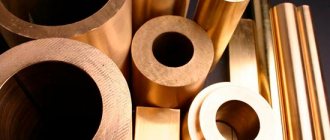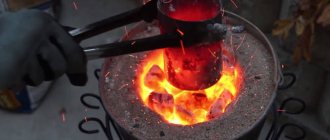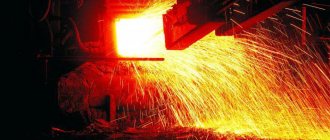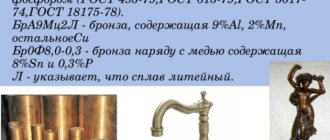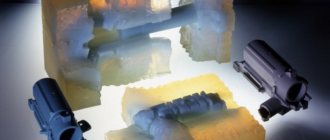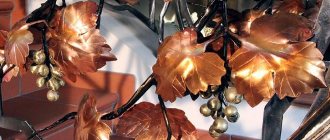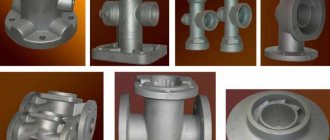Do-it-yourself molding sand for casting – vending-doctor.ru
Mankind knows many metals and alloys based on them. One of the most famous is brass. This is a copper-based compound to which third-party non-ferrous metals are added.
Various parts and elements for electrical equipment are made from this material. Casting brass allows you to make workpieces of various shapes and sizes from it.
It can be carried out at the enterprise or at home.
Brass casting
Characteristics and applications of brass
Brass is an alloy whose main components are copper and zinc. The traditional compound is a mixture of 70% of the first metal, 30% of the second. However, there are materials where the zinc content reaches 50%.
To understand how to work correctly with this connection, you need to understand its characteristics:
- Melting point - up to 950 degrees.
- Density - about 8.7 tons per m3.
- Electrical resistance - 0.08 microns per meter.
- Heat capacity - 0.377 kJ/(kg K)
Brass products can be a mixture of copper and zinc, or these two components and additional alloying additives. The alloy is used in various industries:
- production of components for watches;
- creation of figurines, jewelry, interior elements;
- production of parts used in mechanical engineering;
- creation of components for electrical equipment.
Brass has good weldability. In addition, it has a high corrosion protection rate. Due to these characteristics, the alloy is used as a protective coating for other metals in the manufacture of metal structures.
History of technology
Historians say that brass appeared simultaneously with bronze. Alloys were used to make jewelry, tips for tools, weapons, dishes, and cutlery.
To make any item, you had to know the technology of brass casting. Over time, the method developed and improved. Today, the material can be made at home or in production. To do this, you need to accurately carry out the technological process, follow the rules, choose the right tools and raw materials.
Product made of brass
Subtleties of technology
The technology of artistic brass casting is similar to the production of bronze products. It has some subtleties that should be discussed before starting to work with materials:
- Before making a casting, it is necessary to select consumable metals and melt them. For this, different types of ovens are used. Due to the low melting point, you can make a structure for melting yourself. It will consist of a gas burner and a heat-resistant container.
- An important stage during the manufacture of products is pouring the molten raw materials into a mold prepared in advance. The duration of the procedure is no more than 2 minutes. If pouring is done incorrectly, the product may end up with slag pits, burns, depressions, and joints. The finished part will be damaged or require additional processing.
- The alloy must be cooled evenly, without the use of coolants.
- The part requires additional processing after removal from the mold. After casting, sprues, fills, vents, and profits remain on it. They need to be removed.
We must not forget that forms are reusable and disposable. From the first, the workpieces are removed using pliers. The second ones are broken with a hammer.
Disposable flasks
Having learned what a flask is and how it is used, it is easier to understand the intricacies of the process. It no longer seems so complicated, but rather interesting and simple. Modern technologies allow you to try to make your own jewelry almost at home.
The Chinese market offers a wide range of disposable molds with ready-made molds. All that is needed to work with such a form is the required amount of precious metal and the ability to melt it.
They are used both by jewelers who do not have their own foundry, and by freelance craftsmen who make custom-made jewelry.
Anastasia Razulite
What is required for casting?
To melt brass, you must initially prepare equipment and tools for the work. This includes:
- Molding compositions. Made from fireproof materials. The shape is selected depending on the required finished product.
- Special tongs used to make it are removed from the molds after hardening.
- Heating equipment. You can use a purchased model or make a stove yourself. For assembly you will need fireclay bricks and fireproof mastic. For heating, you can use a gas burner or nichrome wire.
- A crucible is a container that is filled with consumables. They melt when heated. Then the master pours the molten metals into a mold prepared in advance. The crucible is made of clay or graphite. Additionally, heat-resistant coating is used, which increases the durability of the container.
In order to remove the crucible from the furnace, semicircular tongs are used.
Jewelry casting at home for beginners
Greetings, Samodelkins!
Today I will show you the basics and provide some basic knowledge that will help you cast your first piece. You will also see the process of modeling, casting, processing, forging a ring to size and blackening brass. And all this in one article.
The DIY master specifically, whenever possible, used the most accessible materials and means, which may not be entirely suitable, but nevertheless work. Therefore, don’t rush to say that there is jewelry wax for modeling; that’s not what we’re talking about here. To make a model of the ring, the author took the most ordinary candle paraffin and melted it with a burner, collecting it in a tin can.
After melting, it remains liquid for a very long time, and during the curing process it is plastic. As paraffin hardens, it becomes even looser and brittle. This is clearly one of the worst materials for modeling, but again, it is a budget, affordable option.
For the ring model we will need an M20 bolt. This bolt is approximately the size of the author's fingers. Since the bolt is cold, paraffin quickly hardens when it comes into contact with it and sticks to it.
This works to our advantage, so we dip the bolt in molten paraffin, building up the shrunken layer over and over again.
Giving the cast product an attractive appearance
The product, which has just been removed from the mold, looks quite unpresentable. Burnt molding sand may remain on its surface and other surface defects may be detected. The first step in bringing a bronze cast object back to normal condition is cleaning it. To perform this procedure, metal brushes or grinding machines are used (a wire wheel is installed on them as a working tool).
Despite the fact that brass and bronze have good fluidity and, when casting, fill all the recesses in the mold well, it is almost impossible to obtain a fine pattern on the finished product. To form such a pattern, a finishing operation such as embossing is used. It is performed using a special tool. Depending on the complexity and subtlety of the pattern that needs to be formed on the surface of a cast bronze product, the embossing operation can take a different amount of time.
Hand-chased bronze figurine
It should be borne in mind that embossing is the most creative stage of the casting procedure; the quality and thoroughness of its execution directly determines how the product will ultimately look. That is why such an operation should be approached very responsibly and with maximum care.
Depending on the idea of the craftsman who casts bronze or brass, as well as on the requirements for decorativeness, the surface of the casting can be covered with artificial patina, gilding, silver, or a layer of nickel or chromium. Objects that have a complex structure are often cast not as a whole, but in separate parts, which then must be correctly connected. This connection is made using special locks originally provided for in the design. In order not to confuse such locks and to correctly compare their elements with each other, they are often marked.
Casting brass into plaster molds - Metalworker's Guide
Gypsum hemihydrate CaSO4 mixed with the semianhydride substance γCaSO4 is used for castings from non-ferrous alloys, as well as for the manufacture of models and model plates; for small castings a mixture of 20% gypsum, 80% asbestos + water is made. The mechanism of strength formation is hydration (the more asbestos, the less water is taken).
For thin-walled castings with thin relief and a clean surface, instead of asbestos, fine-grained quartz powder is recommended; this mixture is stronger than cement and has low gas permeability, so it is melted in autoclaves at a pressure of 2 MPa for 8 hours, after which it is dried for 10-20 hours. To enhance gypsum mixtures, a surfactant can be introduced into them - this will allow, when foaming the gypsum slip, an increase in the number of gas bubbles, which, during the studied hardening of the mixture, promotes gas permeability.
This gypsum mold has microporosity and high gas permeability, which makes it possible to produce castings from alloys that release an increased amount of gases during hardening.
Chemical processes during hardening of gypsum mixtures
Hardening gypsum-water system
After mixing the gypsum mixture (its basis is anhydrous calcium sulfate, semihydrous gypsum and semianhydride) with water, solid hydrated calcium sulfate is formed in accordance with the equation
2 (CaSO4)• H2O+ 3H2O= 2 (CaSO4• 2H2O). (14)
The hardening time of gypsum depends on the grade of gypsum, the amount of water, the temperature of the water, and the dispersion of the gypsum. With a low water content, the mixture is poorly poured, hardens quickly, and releases an increased amount of heat, with a simultaneous increase in the amount of volume. The hardening time of gypsum increases with increasing water temperature, so cold water should be used.
Technological properties
of gypsum mixtures
With a sufficient amount of water, the gypsum mixture is mushy, quite fluid, hardens slowly and does not have a tendency to increase in volume. After the mixture hardens and the mold is heated before pouring, shrinkage occurs, which can cause cracking of plaster molds. The more water semi-aqueous gypsum contains, the greater its shrinkage when heated.
To reduce shrinkage, an increased amount of pulverized quartz, a minimal amount of gypsum and additives that cause expansion of the gypsum are introduced into the gypsum mixture.
The strength of dried gypsum mixtures increases with a decrease in the content of water and pulverized quartz. Mixtures of gypsum with quartz filler are relatively low-elastic, so forms made from them are deformed slightly. Quartz mixtures require less water than asbestos, since they absorb less of it. The linear shrinkage of such mixtures is also less than asbestos mixtures.
Advantages of gypsum mixtures:
— Satisfactory strength
- easy knockout
Flaws:
- insufficient heat resistance
- limited scope
— the presence of shrinkage of the mixture and possible cracking of the molds. To reduce cracking, pulverized quartz is introduced and the amount of gypsum is reduced.
Casting in ethyl silicate molds
Ceramic molds are used in the production of investment castings or the Shaw process. The molding mixture has a mushy consistency and consists of a solid ceramic component and a liquid binder.
The following refractory fillers are used for ceramic molds:
- dusty quartz (marshallite) PC1, PC2, PC3. For ceramic molds PK2, PK3.
- electrocorundum Used for refractory Me and Mg-based alloys.
- zircon flour
- titanium dioxide. Used for high-alloy steels and other alloys with a basic oxide nature.
Most often, silica SiO2 is used for ceramic forms in the form of dusted quartz (marshallite). As noted above, quartz, due to changes in its crystalline modifications, is characterized by a sharp change in volume when heated and melts at a temperature of 1550°C.
In addition to quartz, the following is used in the manufacture of ceramic molds:
Alumina
A12O3 - artificial corundum - is used in the form of powder and crumbs, the melting point is 2045 ° Q when heated, no significant volumetric changes occur.
Silimanite
А12О3• SiO2—natural aluminum silicate—suitable for precision casting of non-ferrous alloys; melts at a temperature of 1545° C.
mullite
3A12O3• 2SiO2—aluminum silicate obtained artificially from kaolin; melts at a temperature of 1810°C.
Zircon
ZrSiO4—zirconium silicate; melting temperature up to 2430° C.
Molochit
is calcined kaolin, which, in addition to SiO2 and Al2O3, contains oxides of titanium, iron and alkali metals.
The following is used as a liquid binder:
Alcosols,
or
hydrosols
, which are colloidal solutions of certain organic silicon compounds.
Among them, the most important is tetraethyl orthosilicate,
the chemical formula of which is SiO4 (C2H5)4. The connection of individual filler grains is ensured by a gel film formed under the action of water and an acidic hydrolyzed catalyst.
Heterosiloxanes
are aluminosilicate esters, which, under the influence of moisture contained in the air, hydrolytically split into colloidal solutions of aluminum and silicon compounds. The resulting gel after firing binds the ceramic grains in the form of strong aluminosilicates.
-Chloro-ethoxytitanate
used in benzene solution as a binder for alloys of titanium and other metals with high reactivity.
Aminoalkyl silicate
and
basic aluminum nitrate
are used in the form of alcohol solutions, the hydrolysis and gelation of which are caused by ammonia.
The mushy molding mixture is applied to the model in several layers, sprinkled with ceramic chips and dried. After removing or melting the model, a ceramic mold is formed. Drying is carried out slowly by raising the heating temperature to 120 ° C for several hours.
After removing the remaining carbon compounds and strengthening the silicate gel, the molds are sequentially fired at temperatures of 400, 600, 800, 1000 ° C for 6-8 hours. The molds are poured with metal immediately after firing, until they absorb moisture from the air.
As already indicated, in quartz materials, upon cooling, reverse recrystallization occurs, which can cause cracking of the forms.
Copper casting
Copper is one of the first metals mastered by mankind.
Copper
Thanks to its low melting point and high plasticity, it has not lost its popularity for the fifth millennium. Red metal is widely used both in industry and at home to make jewelry, crafts and parts by casting copper.
In industrial settings, technologies such as
Copper casting
- Casting copper into molds
- Powder metallurgy
- Electroplating
- Hot and cold rolled
- Sheet stamping
- Wire drawing
- Mechanical restoration
They require complex and expensive professional equipment, highly qualified personnel and are accompanied by high energy costs.
Wire drawing of copper
At home, in a small workshop, simple technologies are used, largely repeating the work techniques of the Copper Age masters. This includes copper casting and wire drawing, as well as forging and embossing. Despite the simplicity and antiquity of technological techniques, home craftsmen achieve high quality products. Sufficient casting accuracy is ensured by careful production of the mold.
Characteristics of copper
Copper is a metal with a relatively low melting point (1083C), a density of 8 g/cm3 and high ductility. It occurs in nature in the form of nuggets.
Thanks to these qualities, it became the first metal mastered by mankind. Archaeologists have found tools and weapons in burials dating back to the 3rd millennium BC.
Most likely, humanity mastered copper casting even earlier, at the end of the Stone Age.
Basic properties of metals of the copper subgroup
The Latin name of the metal, Cuprum, is associated with the name of the island of Cyprus, a famous ancient center for the production of bronze products. Copper-based alloys - bronze and brass - have high strength and are less susceptible to oxidation. Bronze was widely used as the main metal of mankind until the development of mass steel production technologies.
Copper has excellent electrical and thermal conductivity. This leads to its widespread use in electrical and thermal engineering.
In addition, copper has pronounced bactericidal properties.
Copper smelting and casting equipment
Casting copper at home does not require particularly complex or expensive equipment. Buying it or making it yourself is quite within the capabilities of a home craftsman.
Required
- Crucibles are cylindrical open vessels.
Examples of graphite crucibles
- Steel tongs for removing and placing the crucible in the furnace.
- Muffle furnace or gas burner.
- Steel hook for removing oxide crust from the surface of the melt.
- Casting mold.
First of all, you need to melt the copper. The better the feedstock is crushed, the faster the melting will occur. Melting will occur in a crucible made of ceramic or refractory clay.
The muffle furnace must be equipped with a thermometer and a glass window for visual inspection.
Electronic temperature control and maintenance system will make copper casting easier and provide better casting quality.
Molds for copper casting are made based on the model. Depending on the chosen technology, the molds can be disposable (from a mixture specially molded in the formwork) or reusable - steel molds. Recently, molds made from high-temperature silicone have become widespread.
At home, disposable forms are more often used. The model is made from wax or special types of plasticine. The model completely repeats the spatial configuration of the future product. When a hot melt is poured into a mold, the wax melts and is replaced by metal, which takes its place and repeats all the details of the mold's relief. This form is called lost wax.
Burnout mold for copper casting
There are also burnt forms. They use a model made of flammable material, such as papier-mâché. In this case, the model burns when a high-temperature melt is poured, the combustion products in the form of gases exit through the filling hole.
Features of brass casting
Mankind knows many metals and alloys based on them. One of the most famous is brass. This is a copper-based compound to which third-party non-ferrous metals are added.
Various parts and elements for electrical equipment are made from this material. Casting brass allows you to make workpieces of various shapes and sizes from it.
It can be carried out at the enterprise or at home.
Brass casting
Preparatory work
Before you start making a casting, you need to prepare for the main work. Initially, you need to develop a sketch of the future product and sketch it on paper.
Using the finished drawing, make a mold for pouring the molten alloy. It is made from clay and quartz sand. There are reusable and disposable forms.
The former are more difficult to produce, but they can be used in the serial production of products from metal alloys.
After the brass part is manufactured, additional processing will be required to eliminate defects that occur during casting. For this purpose, the casting surface is subjected to chemical treatment. Using active solutions, defects are removed from the surface of workpieces.
Casting surface
Carrying out work
To melt brass at home and make a high-quality casting, you must follow the technological process exactly and do not reverse the steps. Carrying out work:
- The crucible is filled with crushed consumables. It is desirable that their size be as small as possible. The speed of the smelting process will depend on this.
- Using tongs, the container is placed in the oven. The heating elements turn on.
- The crucible is heated until all the pieces of metal are melted.
- The crucible is removed from the furnace. There will be a film on the surface of the molten brass that needs to be removed with a metal rod.
- All that remains is to pour the molten alloy into the mold and wait for it to cool.
If the mold is disposable, you need to break it with a hammer or break it with any tool. Reusable structures are separated.
When casting, you need to take into account the safety rules:
- Wear protective gloves and clothing made from heat-resistant materials.
- Safety glasses will protect your eyes from fumes and drops of molten metal.
- The room must be ventilated. Vapors concentrated during metal melting can be harmful to health
- Avoid contact of heating elements with flammable liquids, materials, and substances.
By following safety rules, you can protect yourself from injury.
Brass casting is a technological process that can be repeated at home. To do this, you need to prepare equipment, assemble a homemade furnace, make molds, and perform melting and casting step by step. Allow the molten metal to cool and carry out additional processing of the finished product.
( 1 rating, average 5 out of 5 )
Foundry models
Artistic casting of bronze and brass involves obtaining the smoothest possible surface, so fairly hard materials are used to recreate the model:
To obtain the smoothest possible surface, it is subjected to elimination of porosity by puttying, priming and varnishing. Casting models are made split; one-piece - suitable for casting products of simple shapes; special for parts with a rather complex configuration.
For multi-component temperatures, the temperature regimes increase to 895 °C - 1070 °C due to the introduction of alloying components with a high melting point.
Mold casting: manufacturing, sand, shell molds
According to historians, the bronze casting is 12 thousand years old. Initially, using this technology, jewelry and simple tools were made from bronze. Over time, this technology has been improved, and today it is a method by which many unique products are created from this alloy.
The current level of development of bronze casting makes it possible to produce various objects from this copper alloy not only in production, but also at home.
Thanks to the invention of bronze, as well as the development of its processing technologies, the main of which is casting, we can still enjoy the sight of works of art that were created by masters back in the Middle Ages and ancient times.
Antique bronze set of writing instruments
Bronze casting, as well as brass casting, another alloy based on copper, gained the greatest popularity in the era of classicism and European Baroque. It was in those days that people learned to use these materials to create unique interior elements and decor.
Such alloys created on the basis of copper are still actively used in the manufacture of:
- items used for interior decoration;
- gates and fences that perform not only a decorative, but also a protective function;
- sculptural compositions and souvenirs;
- bas-reliefs and design elements of lighting fixtures - chandeliers and sconces;
- elements of staircase structures and entrance groups.
Bronze casting for making knife handles
Many of these products, which are not large in size or complex in shape, can be made from bronze and brass not only in production, but also at home.
Stages of artistic bronze casting
In order to perform high-quality casting from a metal such as bronze, it is necessary to adhere to a certain sequence of actions. First of all, you should reflect in the sketch the shape of the product that you plan to cast from bronze.
Based on the sketch, which is created by professional artists and designers at modern enterprises, specialists create a drawing that accurately reflects all the dimensions of the future casting.
It is the drawing that is the basis for making an accurate model, which is used to produce a casting mold.
To create a model of a product that will subsequently be made from bronze by casting, various materials can be used, in particular:
- Ivory;
- wood (in this case, preference is given to such varieties of this material as pine, alder, beech, linden);
- gypsum;
- various types of polymer materials.
The cavities of the wax model of the future figurine are filled with clay, which will be removed after casting
To make the surface of the model as smooth as possible, it is primed, puttied and covered with several layers of varnish. When making a casting model, not only different materials can be used, but also different design approaches. So, models can be:
- detachable (these are complex structures consisting of several component elements that can be connected to each other along flat or complex surfaces);
- one-piece (monolithic models, the simplest type, most often used for casting at home);
- special (this includes skeletal or molding templates used in cases where it is necessary to make a casting mold for the manufacture of objects with a complex configuration).
The next step after creating an accurate model of the future bronze product is the production of a casting mold. For this purpose, special devices and equipment are used, and the main materials used in this case are molding mixtures created on the basis of clay and carefully cleaned quartz sand.
The longest stage of bronze casting is molding - making a casting mold
In such a technological process as casting, made from bronze and any other metal, the casting mold plays a decisive role.
It is into such a mold, the internal cavity of which must exactly repeat the product being cast, that the molten metal is poured, and in it it cools, forming the finished casting.
Foundry molds, used both in production and at home, can be single-use or reusable, which is determined not only by the material from which they are made, but also by the features of their design.
Microcasting at home
A lot of cast parts made of non-ferrous metals and their alloys are used in technology, including quite complex and miniature ones, the serial production of which can only be afforded by enterprises with precision technology.
However, single (or even small-scale) microcasting can be organized at home.
It turns out that modern technology can be rivaled by the ancient method of injection molding using a simple manual centrifuge.
Almost everything that is needed for such micro-casting can be made by hand. Costs are minimal.
Indeed, the flask required for casting in this case is a piece of ordinary steel pipe with a diameter of 50-60 mm and a wall thickness of 2-3 mm. For casting products of different sizes, it is good to have several flasks of different diameters, provided that each one fits freely in the centrifuge bucket. If you have such a set, you can cast a whole series of parts one by one.
A centrifuge matches the flask in simplicity. Its wooden handle has a length of about 200 mm and a diameter of 20-30 mm. An M8 bolt is inserted into the axial hole of the handle. A metal earring is attached to it using a locked nut so that both the handle and the earring rotate easily without interfering with each other.
A bucket for a flask is suspended from the earring on a rocker arm made of 6 mm steel wire. The side of the bucket is made of a 60 mm piece of 80x3 mm steel pipe, and the welded bottom is made of a steel sheet 3 mm thick. The 200 mm high bow is made of the same 6 mm steel wire.
In order to confidently use such a centrifuge, you must first practice a little, remembering how in your school years in the physics room you had to twist a bucket of water on a string while studying centrifugal force.
True, now, instead of string and a bucket of water, in my hands I have a homemade centrifuge with a bucket, on the bottom of which there is a plastic cup (to prevent it from breaking).
But the water in it is ordinary, like it was in school physics experiments. And the action of centrifugal force is similar.
Holding the handle firmly, you need to rotate the entire chain (earring - rocker - bucket and vessel with water) around the bolt-axis, trying not to spill a drop.
Technology for producing high-quality micro-injection molding of non-ferrous metals and alloys using a manual centrifuge:
1 — bolt-axle; 2 - wooden handle; 3 — metal, easily rotating earring; 4 — locked nut; 5 — steel wire rocker; 6— bow; 7 — side of the bucket; 8 — bottom of the bucket; 9 — flask; 10 - molding compound; 11 — wax model; 12 — wax ball with technological wire pins; 13—casting mold with sprue channels, formed after melting the wax and removing the pins; 14—molten metal (alloy); 15 — flame of a gasoline burner; filling the mold with the melt while rotating the centrifuge and subsequent operations for removing and finishing the finished product are not shown
Once you get the hang of it, you can subsequently deal not with water, but with molten non-ferrous metal (or alloy), which will be pressed by centrifugal force through the gating channels into the casting cavity in the flask installed in a bucket instead of a plastic cup.
Perhaps the most difficult and time-consuming thing in micro-casting is the production of a three-dimensional, life-size wax model.
This one is molded from wax by hand, using a heated eye scalpel or a hot darning needle. Even small details are worked out with the utmost care, because molten metal (as well as any alloy) does not forgive mistakes and sloppiness. Moreover, casting, performed in a centrifuge under pressure, reveals all the flaws of the model!
In my practice, I use wax models whose height is no more than 40 mm and diameter is 50 mm. At the same time, I try to maintain proportionality so that the mass of metal in the casting does not exceed 40 g. The limitations are mainly due to the low power of the burner I use for melting.
Subtleties of technology
In order to perform artistic bronze casting or make a practical product from this alloy, it is necessary first of all to obtain molten metal. Various types of furnaces are used for melting metal: induction, arc, flame, etc. In the simplest version (when casting at home), you can use a regular gas burner to melt bronze, placing it under a special container for the melt.
The capabilities of small furnaces, which you can make yourself, are quite enough to melt non-ferrous metals and their alloys, which also include brass and bronze.
To melt a small amount of bronze you need a fire brick and a gas burner
The most important step in bronze casting is filling the mold with molten metal. Despite the fact that such pouring lasts only 1–2 minutes, the correctness of its execution directly affects the quality characteristics of the finished product. The result of incorrect filling can be such defects as:
These bronze castings developed cavities due to poor cleaning of the crucibles before pouring.
The metal, which has already been poured into the mold, must be allowed to cool to the required temperature, which, depending on the brand of alloy used, may vary. The procedure for removing the finished product from the mold depends on what type it is - disposable or reusable. In the first case, it is simply broken with a hammer, and the casting is removed using pliers. Reusable molds, accordingly, do not need to be broken: they are simply opened along the surface to be joined and the casting is carefully removed from them.
Casting brass into plaster molds
Gypsum hemihydrate CaSO4 mixed with the semianhydride substance γCaSO4 is used for castings from non-ferrous alloys, as well as for the manufacture of models and model plates; for small castings a mixture of 20% gypsum, 80% asbestos + water is made. The mechanism of strength formation is hydration (the more asbestos, the less water is taken).
For thin-walled castings with thin relief and a clean surface, instead of asbestos, fine-grained quartz powder is recommended; this mixture is stronger than cement and has low gas permeability, so it is melted in autoclaves at a pressure of 2 MPa for 8 hours, after which it is dried for 10-20 hours. To enhance gypsum mixtures, a surfactant can be introduced into them - this will allow, when foaming the gypsum slip, an increase in the number of gas bubbles, which, during the studied hardening of the mixture, promotes gas permeability.
This gypsum mold has microporosity and high gas permeability, which makes it possible to produce castings from alloys that release an increased amount of gases during hardening.
History of technology
Historians say that brass appeared simultaneously with bronze. Alloys were used to make jewelry, tips for tools, weapons, dishes, and cutlery.
To make any item, you had to know the technology of brass casting. Over time, the method developed and improved. Today, the material can be made at home or in production. To do this, you need to accurately carry out the technological process, follow the rules, choose the right tools and raw materials.
Product made of brass

